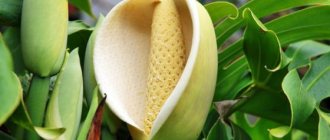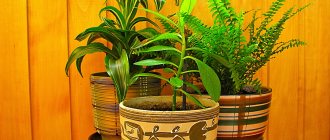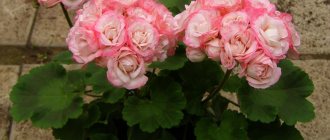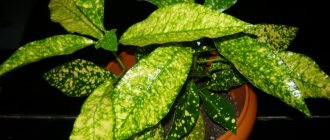There are many varieties of Saintpaulias, and their number increases every year. African Night, one of the largest and darkest varieties.
There are reasons why it is not to everyone's taste, but its color does not leave anyone indifferent. Photos and descriptions of the variety can be studied in more detail in the article.
And when planning to get yourself a new pet, it is important to know:
- What will the flower be like?
- And how to properly care for it.
Otherwise you can :
- Or be disappointed;
- Or destroy the plant.
Violet African Night (K. Katkin)
In terms of size, the African can be classified as standard, and some individuals can even be classified as large varieties . Saintpaulia leaves:
- Large;
- Dark green with a reddish underside;
- Prone to impaired horizontal growth;
- And they reach to the top.
The flowers are large, deep dark purple, and abundant light can result in blue blooms .
African night original.
This variety was bred in Odessa by breeder K. Katkin . For a long time, it was considered the darkest variety, and this was the reason for its popularity. But the simplicity of the flower and the dimensions of the rosette, after the appearance of darker options, pushed this beauty to the lower positions.
After reproduction, sport flowering is quite often observed . The color usually remains the mother's, only the underside of the petals is slightly lighter.
African night sports.
Attention! Most of these offspring have slightly double flowers, which, as before, are huge in size, but more of them are formed on the peduncle (standard 1-2, sport 3-4).
We'll talk about care and reproduction below.
TOP 10 most popular varieties for beginners
When choosing a green beauty, you need to be guided not only by external data, but also by your own ability to provide the conditions.
Having studied the opinions of experienced collectors, we bring to your attention the most unpretentious varieties of violets for beginners, which do not require particularly close attention.
"Arctic Frost"
It grows in almost any conditions; neither bright sun nor shade hinders it. Feels good on any window. Tolerates different levels of humidity.
But if you want to admire the blooms longer, it is better not to leave them for a long time under the scorching rays of the sun.
"EK-Nautilus"
Author: Elena Korshunova. Easy to grow.
White-blue semi-double flowers with blue stripes from the middle and wavy petals will win the heart of even a sophisticated connoisseur.
The rosette is small, medium green, flat.
Hot Spot
Lovers of red flowers will like it. Abundant flowering and corrugated edges of the petals will not leave anyone indifferent. Leaves are bright green.
One of the fastest growing varieties.
"Balchug flight"
Chimera with a small neat rosette and strong peduncles bearing up to 7 flowers. Sometimes such a bouquet obscures the rosette with its size.
Quite stable. It forms many stepsons from the stem, which simplifies reproduction.
Fast growth, early and luxurious flowering in minimally comfortable conditions allows us to recommend this variety to beginning gardeners. And if you organize lighting 12 hours a day, the flowering will become more abundant and longer.
"Morenkönig"
It surprises with the color of the petals - they are like black velvet. You won’t be able to forget what you saw, this plant is so impressive.
It can grow both indoors and outdoors, this is facilitated by its cold resistance and unpretentiousness.
Favorite Daughter
Author: Boris Makuni. A large rosette of wavy soft lilac flowers blooms earlier than others.
And the bush itself develops quickly even with standard care and will not cause trouble to its owner.
LE-Peach Shine
The result of selection by Lebetskaya E
The rich peach shade in the center of the flower and the densely corrugated edge reminiscent of lace attract attention.
The leaves are collected in a dark compact rosette.
"Adonis"
It became popular back in the nineteenth century in France. It differs from other Saintpaulias in having a yellowish center against a background of blue petals with a dark blue spot.
The bush is about 25 cm in height, with light green foliage. Feels great both on the windowsill and in the flower bed.
It will delight others with its luxurious blooms already in April and will not disappoint until late autumn.
Abendglut
Despite the average size of the bush, it has large – 6 cm flowers of a cherry hue with brownish inclusions. And there can be up to two dozen of them at the same time!
Flowering is possible twice with a short break:
- April-August;
- September October.
Violet overwinters without problems and is undemanding to conditions.
Mas Glass Sleep
The crystal slipper is easy to maintain and is suitable for starting a collection.
The combination of light green leaves with a light border and snow-white flowers with a bluish border gives an elegant look. And the ruffled edge is reminiscent of ruffles on a fashionista’s dress.
This species is valued for its year-round flowering and even rosette, which is not spoiled even by a lack of light.
Other
If the varieties listed do not catch your attention, consider the following options. According to some gardeners, non-capricious varieties include:
- Pink Amiss;
- Frosty Frolic;
- Warm Sunshine;
- Golden Autumn (Sorano);
- Vinces Choice;
- Suncoast Circus Candy White sports;
- Raspberry Crisp;
- Fire Moths;
- LE-Macho;
- Halo's Aglitte;
- LE-Rings of Saturn;
- AB-Caramels;
- Balchug Avenir;
- Spring Rose;
- Mac's Southern Springtime;
- Blue watercolor.
Conditions for cultivation
In terms of care, the African Night variety is no different from others:
- Temperature. Violet is afraid of cold; the lowest and highest temperatures are 16 and 24°C, respectively:
- In winter, during the dormant period, it is necessary to reduce the heat to 16-18°C, this will give the bush a good rest and will delight you with flowering in the spring;
- In summer, you should not overheat the flower; the temperature should not exceed 24°, and 22° is optimal.
- Between seasons, temperature changes should be carried out gradually, without sudden changes;
Important! If the temperature changes sharply, the plant may get sick and even die. When the heat drops, rot forms, and a sharp jump leads to withering and drying of the leaves and core.
- The soil. All violets need light soil mixtures. You can purchase specialized soil in the store, or mix the ingredients yourself; the proportions depend entirely on the type of watering. The mixture consists of:
- 3 parts peat;
3 parts soil;
- 2 parts perlite;
- And 2 parts of sphagnum moss.
But flower growers often change it depending on their conditions and preferences . For wick irrigation, it is ideal to mix only peat and perlite in equal parts.
Soil for violets can be purchased at a specialty store.
Saintpaulias, including the African Night variety, are not cultivated in open ground. There are several reasons for this:
- Intolerance to direct sun;
- The need for specialized soils;
- The need for root watering, and death from water getting into the center of the outlet;
- They do not tolerate frost.
A young plant usually blooms a year after planting . It may produce peduncles earlier or later if conditions allow it or, conversely, if conditions do not allow it. You need at least 10 hours of daylight and a temperature above 18-20°.
Botanical description
Campsis is a fast-growing, deciduous perennial with a developed rhizome. The roots not only spread deep, but also occupy a vast area. Young shoots may appear at a distance of several meters from the main thickets.
Young shoots have smooth green bark. As they age, they become lignified and acquire a red-brown color. The internodes contain aerial roots and a pair of opposite leaves on long petioles. Each petiole bears 7-11 oval or ovoid leaf blades. The leaves have jagged edges. The front surface is glossy, and the back has slight pubescence along the main veins.
Throughout the summer, numerous inflorescences bloom on the shoots. Each peduncle bears 2-8 tubular flowers with a diameter of up to 8 cm. The corolla consists of five petals fused at the base with bent edges. They are colored pink, orange, crimson or golden.
After pollination, hard pods 8-10 cm long ripen on the vine. Small, pubescent dark brown seeds are hidden in the bivalve pod. A fully ripe fruit opens on its own and the wind easily carries the seeds over long distances.
Growing methods
grow a new bush using standard propagation methods:
- Seeds – after dusting, you can get a seed pod and try to raise the kids. This method is labor-intensive and does not guarantee effect; the seeds quickly lose their similarity, which is quite poor even in freshly collected material. To obtain offspring you must:
- Prepare a container: a flat container that can be tightly covered with film or glass is ideal;
- Pour soil, layer thickness 2-3 cm, moisten with a sprayer;
- Sow the seeds, you can sprinkle them with a very thin layer of substrate, but this is not necessary, cover them with glass or film, creating a greenhouse;
- After sprouting, you can open the container, the flowers dive after they become crowded, earlier it is possible, but this is not justified.
- Leaf and peduncle – take a leaf or peduncle from an adult plant and root it:
- The leaf is chosen from the second or third row, it must be healthy and strong; The peduncle needs to be thick, fresh and strong;
- Root in a convenient way: in water, in soil, with wick watering in moss;
- When the baby appears, it is grown on a leaf (peduncle), and then planted.
Most often, Saintpaulias are propagated by leaves. - Stepson – small babies often form in the axils of the leaves; they are planted in two ways:
- They wait for roots to form (this happens after the plant is deepened, to the level of the lower part of the stepson), then they are separated from the mother plant and planted in a small pot;
- Separate 4-6 leaves at the stage and root them like a leaf.
Attention! All resulting children, regardless of the method of reproduction, are transplanted into larger flowerpots as they grow. Care is no different from adults.
Reproduction
For propagation, choose healthy, thick leaves that are not too small or wilted. Propagation using leaf stems is most successful. Cuttings are rooted in water and soil. The first roots appear after a few days. Growing African violets from seeds is quite difficult at home. Constantly blooming violets in the house indicate that their owner cares about them.
Rules of care
Like all Saintpaulias, African Night requires special care . Violet loves moisture, the air should be sufficiently saturated with water, ideally 60-70%.
Water strictly at the root. If water gets on the leaves, it can cause burns, and at the growing point it can cause rot and death of the individual. The frequency of watering depends on the season:
- In winter, once every 2-3 weeks;
- In the summer every week or even more often.
Advice! Many gardeners transfer their violets to wick watering. This method simplifies the maintenance process and guarantees stable, moderate humidity.
to feed Saintpaulias with liquid products , specialized or for flowering indoor plants. The frequency of fertilizing, as well as watering, depends on the season. It is ideal to focus on the frequency of watering. In summer, every second and in winter, every third watering is carried out with the addition of fertilizer.
Pruning is usually carried out in spring and autumn . This procedure is not necessary, but it prevents the growth of excess foliage and gives the flower more strength to bloom. It is also important to trim faded flower stalks in a timely manner.
Violets have many different diseases.
African night is a fairly disease-resistant variety, but like all violets it cannot be completely invulnerable. Among the dangerous diseases it is worth highlighting :
- Rot. From excess moisture and too low temperatures, the flower can rot. There are different types, some of them can be contagious, but all of them do not develop with proper care;
- Burns. One of the dangerous injuries. A severely burned individual may die without proper resuscitation. To avoid such consequences, you need to place the violet in a bright place without direct sunlight (burns can appear from reflection from the snow, so in winter it is worth protecting the plants from abundant light from the window);
- Parasites. When one violet is attacked, everyone becomes a target. There is no prevention against pests, but stopping them is usually not difficult, the main thing is to identify them in time.
If poorly cared for, violets may become pest-prone.
Transfer
In summer, it is recommended to fertilize once a month, using special fertilizer for violets. The plant with fine roots prefers light and airy soil. The best period for transplanting violets is spring (if necessary, you can transplant at another time). Transplant into a pot approximately the same size as the one in which the violet grew before. If you use a pot that is too large, your violet may not bloom at all.
Features of flowering
African night is famous for the size of its flowers ; they can reach 8-10 cm. Usually it forms several peduncles, on which 1-2 flowers are formed (children may have 3-4). Peduncle:
- Thin;
- Long;
- Usually slopes towards the bottom;
- Initially, it is not vertical that grows, which makes it even more prone to sinking.
With good care, it blooms for a long time, gradually producing up to 20-30 peduncles, but no more than 4-5 at a time, on average 2-3 at a time. None of the methods that work on other varieties will help you get consistent flowering .
Therefore, it is impossible to see a cap of flowers on the African night; sometimes a small cap can be given away by sport variations, but then the flowers are smaller.
The first flowering can be obtained in less than a year . Some starters of this variety bloom at the age of 6-7 months. The duration depends entirely on care, the age of the individual, and the strength of the flower.
Important! On average, flowering lasts from 1 to 3 months; some flower stalks gradually fade and the next ones grow.
Biological description and appearance
The “Watercolor” variety is widely represented not only in dachas, but also in city flower beds. Surely many have met him without even knowing what he is called.
Bush height
The bush of this variety has no significant differences from other relatives: it is moderately spreading, with dark green leaves, of a standard shape. The height of the bush is usually 70–90 cm.
buds
The variety received the name “Watercolor” due to the unusual color of the petals: nature endowed the buds with shades that smoothly transition from soft pink on the outside to peach and milky in the center of the flower. The petals abundantly cover the bud, making it terry. The flowers are large, characteristic of hybrid varieties, reaching a diameter of 10–12 cm, spherical in shape, placed either singly or in inflorescences of several pieces (most often 7).
The aroma of “Akvarel” is highly intense with obvious fruity notes, bright, which makes this variety very popular when creating an aromatic composition for a flower garden.
Bloom
The shrub blooms very profusely and for a long time, until late autumn, which is why it is often grown to decorate large flower beds and for cutting.
Winter hardiness and disease resistance
This variety is very resistant to external influences, has average immunity to many diseases characteristic of its fellows, especially resistant to diseases such as powdery mildew, but winter hardiness is not the strongest side of the shrub, so it is recommended to cover it for the winter.
Pink marshmallow
Violets of this variety are distinguished by variegated rosettes, lush flowers, double appearance, and very bright (light crimson) color of the petals. The species was bred by Lebetskaya. It is quite rare, but very beautiful. Terry stars look like a plentiful, lush cap above the leaves. The leaves are even, variegated - with a delicate white border along the edge of the dark green leaf. One flower reaches 5-6 centimeters, the whole plant looks compact.
Zephyr has very strong peduncles that stand upright. The flowers are light when they first bloom and darken over time. The maximum diameter is six and a half centimeters. Saintpaulia of this variety looks classic, without play or multicolor, and the variegation of the leaves adds elegance to it.
Young foliage can be very light. In general, Zephyr can be quite different under different conditions. Brightness is primarily affected by lighting, which is why Marshmallow often turns out pale and tender. These flowers look more like small roses than violets. Zephyr blooms a lot of foliage, but it does not interfere with the growth of flowers, but, on the contrary, emphasizes the colors. In the first flowering, doubleness may not appear. Saturation is added as one blooms - from beginning to end.











